Last updated on
Discover the practical steps to move a couch without a truck, saving you time, effort and resources while ensuring its safe transportation.
Moving furniture can be a daunting task, especially when you don’t have access to a truck. And let’s face it, couches are some of the most challenging pieces of furniture to move.
But don’t worry, you don’t need to rent a truck or hire professional movers to get the job done. In this article, we’ll show you how to move a couch without a truck and make the process as smooth and stress-free as possible.
So grab your moving gloves and let’s get started!
Table of Contents
Assess the Couch Dimensions

The first step in moving a couch without a truck is to assess its dimensions. This will help you determine the best way to move it and ensure that it fits through doorways, hallways, and other tight spaces.
Start by measuring the length, width, and height of your couch. Write down these measurements so that you can refer to them later when choosing your moving method.
Next, measure any doorways or narrow passages through which you’ll need to move the couch. Make sure that there’s enough clearance for both the width and height of your furniture piece.
If you’re unsure whether or not your couch will fit through certain areas of your home or apartment building (e.g., stairwells), consider taking some photos with a tape measure included in each shot. This way, if necessary – especially if hiring professional movers – they can plan ahead accordingly before arriving on site.
Disassemble the Couch
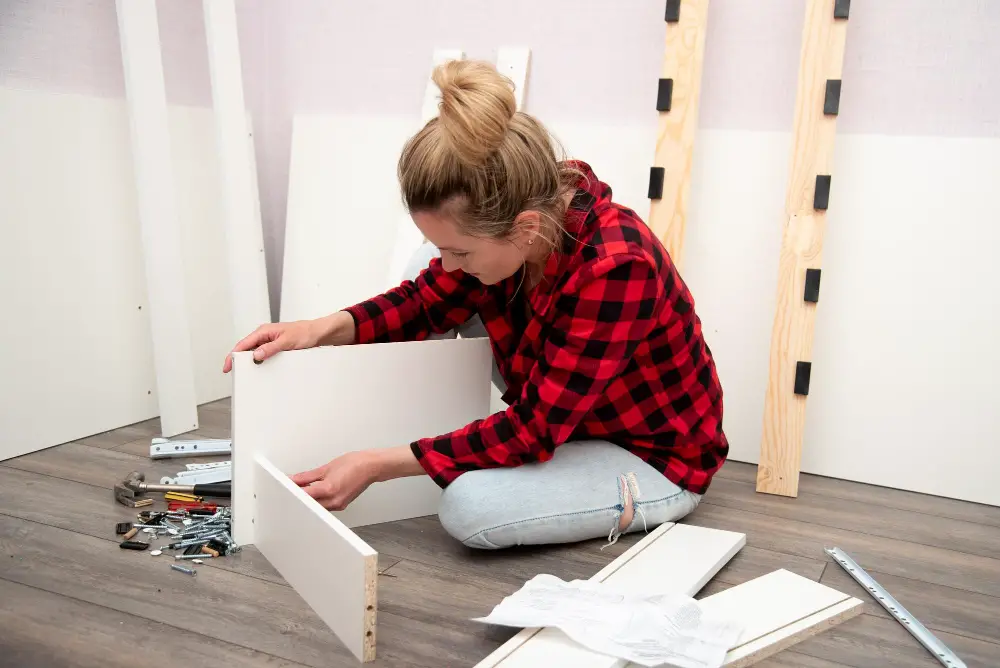
This will make the couch lighter and easier to move, as well as reduce the risk of damage during transportation. Start by removing any detachable parts such as cushions, legs or armrests.
Place these pieces in plastic bags and label them accordingly so that you can easily reattach them later.
Next, use a screwdriver or wrench to remove any screws or bolts holding the frame together. Keep all hardware in one place for safekeeping.
If your couch has reclining features, be sure to follow manufacturer instructions on how best to disassemble those components before attempting anything yourself.
Gather Necessary Tools and Moving Supplies
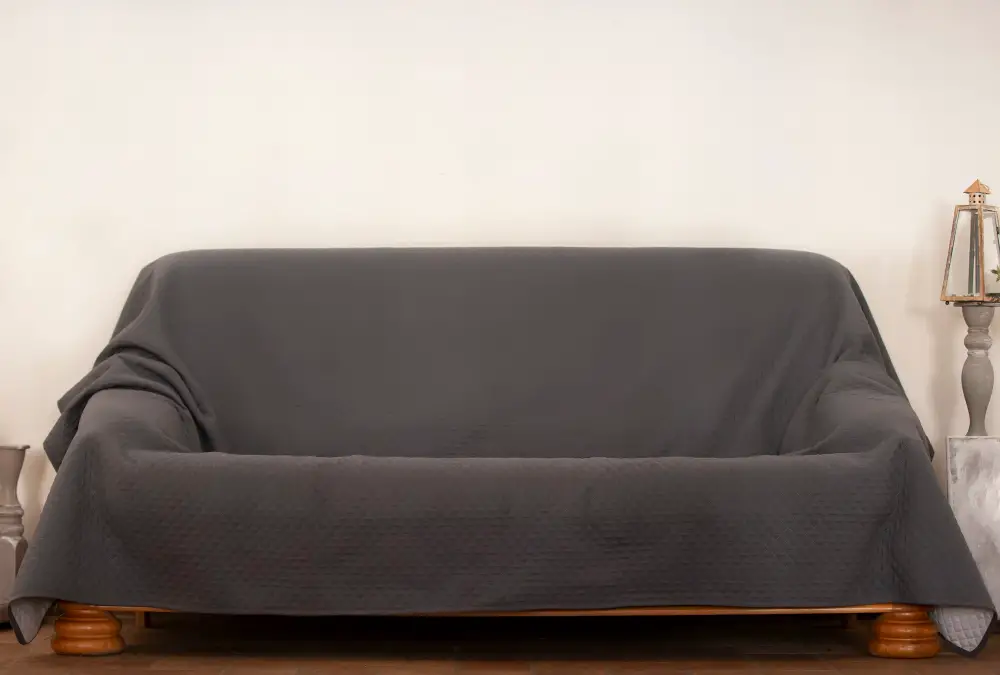
Having these items on hand will make your move much easier and safer.
Firstly, you’ll need a set of furniture sliders or gliders. These are small plastic or felt pads that go under each leg of your couch to help slide it across floors without damaging them.
Next, grab some moving blankets or thick towels to wrap around the couch for protection during transport. You can also use shrink wrap if you have any available.
You’ll also need a dolly or hand truck with straps for lifting heavier pieces like sectionals onto its wheels so that they can be easily moved around corners and up stairs without causing damage from dragging them along surfaces unnecessarily hard on their fabric coverings!
Lastly, don’t forget about gloves! They’re essential when handling heavy objects as they provide extra grip while protecting your hands from cuts and scrapes during transportation.
Protect the Couch and Your Floors
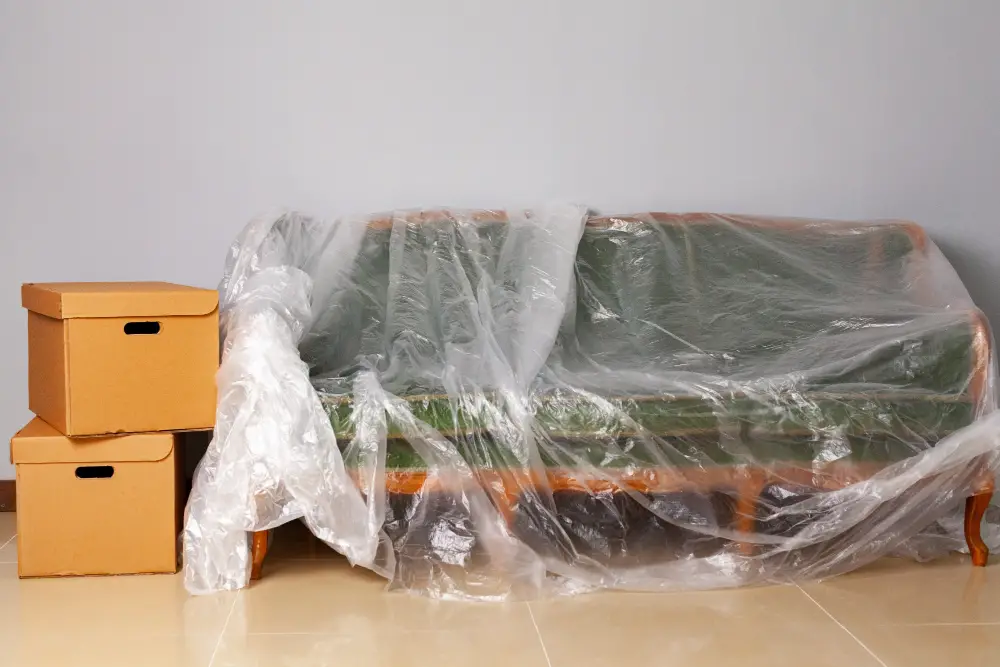
Scratches, dents or stains on your furniture can be frustrating while damages to the floor can be costly. To avoid these issues, follow these simple steps:
Firstly, wrap the couch in moving blankets or bubble wrap to prevent scratches during transportation. Secure them with packing tape.
Secondly, place cardboard pieces under each leg of the sofa before lifting it off its current position; this will help distribute weight evenly across all legs and prevent damage from occurring.
Thirdly if you’re moving on hardwood floors or tiles that are prone to scratching easily then lay down a protective layer such as carpet scraps or old towels along your path of travel for added protection.
Clear the Moving Path
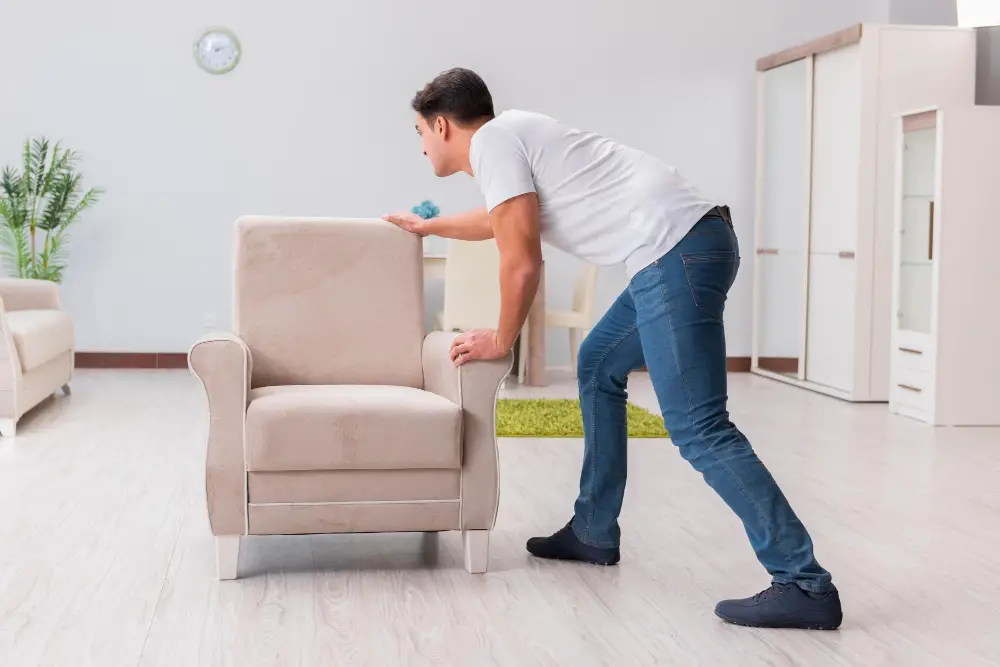
This step is crucial as it ensures that there are no obstacles or tripping hazards along the way. You don’t want to damage your furniture or injure yourself while trying to move a couch through a cluttered space.
Start by removing any small items such as rugs, toys, and shoes from the floor. If you have pets around, make sure they’re in another room or outside during this process.
Next up is clearing larger objects like tables and chairs out of the way. Move them into another room temporarily until you’ve successfully moved your couch.
If there are any doors along the path that need opening wider than usual for easy passage of furniture through them (e.g., front door), prop them open with something sturdy like bricks so they don’t close on their own while carrying heavy loads.
Recruit Helpers or Consider Professional Movers

That’s why it’s essential to recruit helpers or consider professional movers. If you have friends or family members who are willing to lend a hand, don’t hesitate to ask for their help.
Having extra hands will make the process faster and more manageable.
However, if your couch is too heavy or bulky for DIY moving, hiring professional movers might be the best option. Professional movers have experience in handling large furniture items and know how to transport them safely without causing damage.
Before deciding on whether to hire professionals or not, assess your budget and timeline carefully as this could affect your decision-making process significantly.
Choose the Moving Method: Furniture Sliders, Dolly or Hand Truck

There are three main options: furniture sliders, dollies or hand trucks.
Furniture sliders are small disks that go under each leg of the couch. They make sliding heavy furniture across floors much easier and prevent scratches on hardwood or tile surfaces.
However, they may not work well on carpets.
Dollies have four wheels and a flat surface for carrying large items like appliances or boxes. You can rent them from hardware stores for an affordable price per day.
Hand trucks have two wheels and handles that allow you to tilt back the load while pushing it forward with ease. They’re great for navigating stairs but require more physical effort than dollies do.
Carry the Couch Safely Using Straps
Straps are an essential tool for lifting heavy furniture without causing any damage or injury. Here’s how to do it:
- Place a strap under each end of the couch.
- Make sure that both straps are at equal heights and lengths.
- Lift one end of the couch with your helper while holding onto their shoulder for support.
- Slide your arm through the strap on that side, so that you can hold onto both ends of the same strap with one hand.
- Have your helper lift up their side as well while sliding their arm through their respective strap in a similar fashion.
By doing this, you’ll be able to distribute weight evenly between yourself and your helper(s), making carrying much easier than if only one person were attempting this task alone.
Navigate Through Doors and Tight Spaces
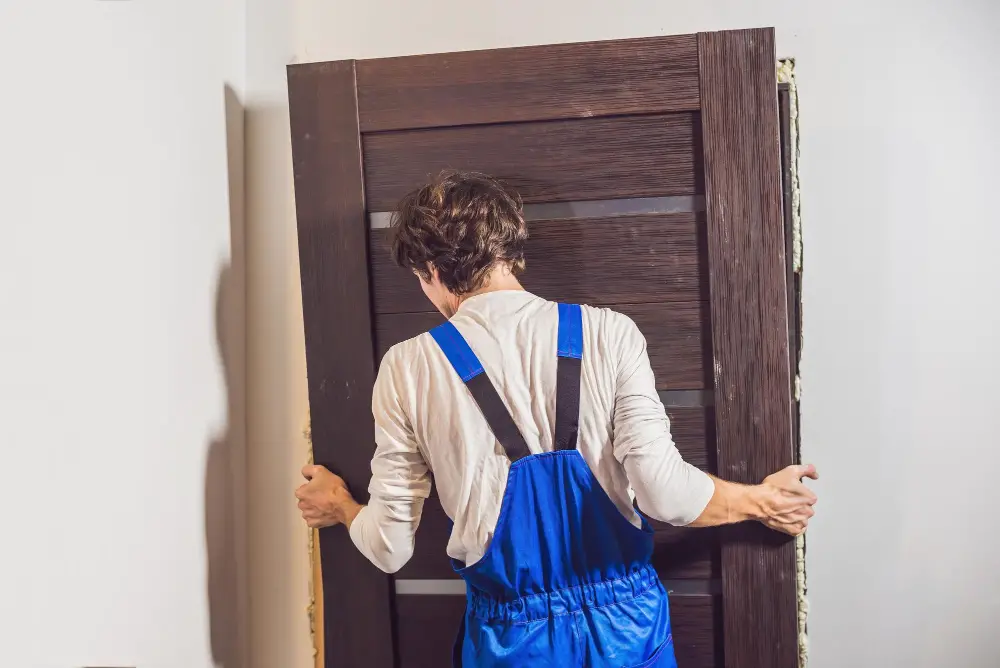
This can be one of the most challenging parts of moving a couch without a truck. To make this process easier, measure all doorways and hallways beforehand to ensure that your couch will fit through them.
If you encounter any obstacles such as narrow hallways or sharp turns, consider removing doors from their hinges or even taking off moldings temporarily. You may also need to pivot the couch at an angle while carrying it through tight spaces.
It’s essential to take extra care when navigating stairs with a heavy piece of furniture like a sofa. Make sure that each person involved in carrying the sofa is aware of their footing on each step before proceeding down or up stairs.
Manage Stairs

With proper planning and execution, it’s possible to manage stairs without damaging your furniture or injuring yourself.
Firstly, assess the staircase dimensions and make sure that your couch can fit through them. Measure both the width of the staircase as well as its height from one floor to another.
Next, clear any obstacles on the stairway such as rugs or decorative items that may cause tripping hazards. Also ensure there is enough lighting for visibility during movement.
Recruit helpers if necessary; having an extra pair of hands will make navigating through tight spaces easier while reducing chances of injury due to lifting heavy objects alone.
When carrying your couch upstairs/downstairs use straps around it for safety purposes and avoid dragging it along steps which could damage both furniture and flooring underneath.
Load Couch Onto a Trailer/flattop If Needed
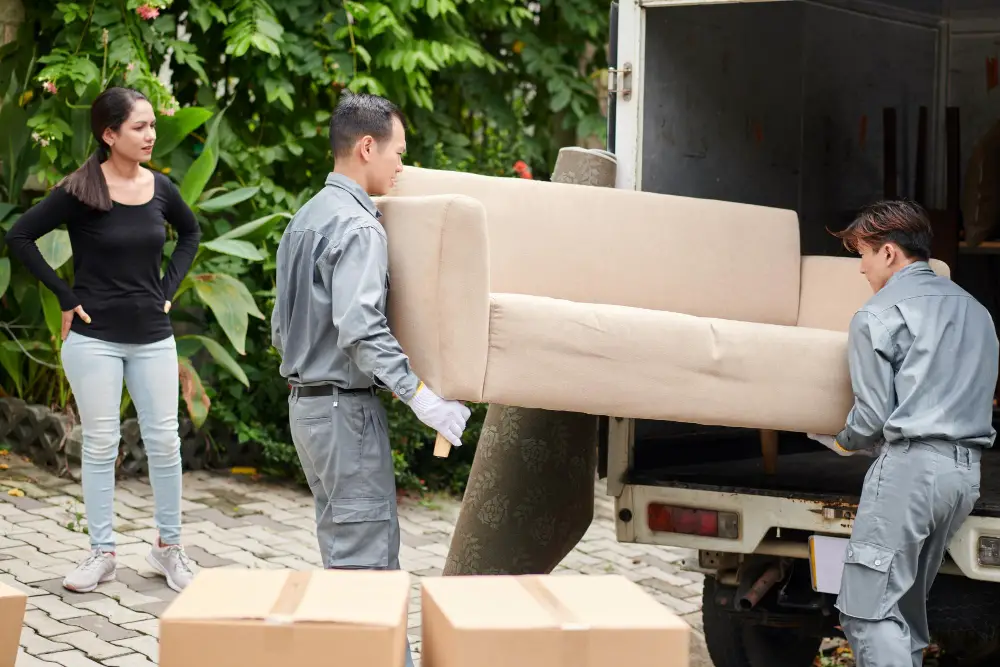
To do this, you’ll need to rent or borrow a trailer that’s big enough for your couch and other furniture. Make sure the trailer has tie-downs so that you can secure everything in place during transport.
Before loading the couch onto the trailer, make sure it’s clean and dry. You don’t want any dirt or moisture getting trapped between layers of fabric during transit.
Next, carefully lift one end of the couch while someone else slides one end of an old blanket underneath it. Repeat on the other side until there is enough blanket under each side to cover most of its length.
Once covered with blankets (or bubble wrap), gently slide it up into position at an angle so as not to damage anything around it before securing with straps across all sides – top-to-bottom and front-to-back – making sure they are tight but not too tight as this could cause damage over time due rubbing against metal parts like hinges etc., which would eventually wear away at them causing rusting issues down line if left unchecked!
Secure Couch During Transport

Failure to do so can result in damage to your furniture and even cause accidents on the road.
To secure your couch during transport, start by using ratchet straps or bungee cords. Place them over and under the couch, ensuring that they are tight enough but not too tight as this could damage the upholstery.
Next, use moving blankets or bubble wrap around any exposed areas of the sofa such as legs and arms for added protection against scratches during transit.
It’s also important to ensure that there is no movement of other items in transit which may knock into your secured sofa causing damages. You can achieve this by packing all other items tightly together with no room for movement between them.
Drive carefully while keeping an eye on traffic conditions ahead of you at all times. This will help prevent sudden stops or swerves that could jostle furniture around inside a vehicle leading up to potential damages.
Reassemble the Couch
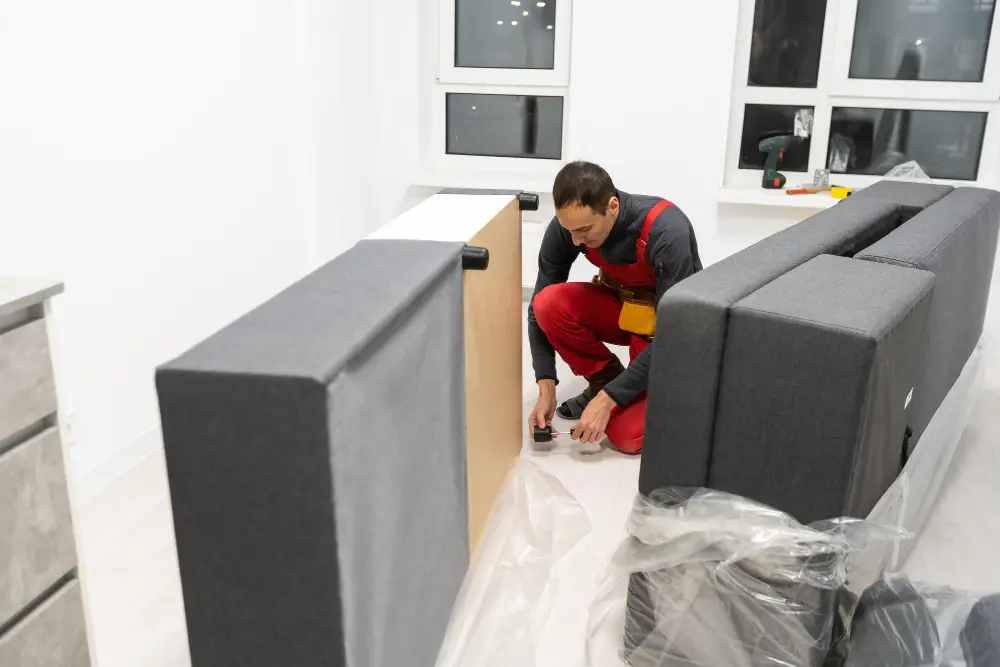
This step is crucial in ensuring that the couch looks and functions as intended. Begin by carefully unpacking all of the pieces and hardware from their protective coverings.
Next, refer back to any instructions or manuals that came with your couch for guidance on how best to put everything back together. If you no longer have these materials, don’t worry! You can usually find them online through a quick search.
Take care when attaching any screws or bolts so as not to strip them or damage the frame of the couch. Once everything is securely fastened in place, give your newly assembled piece a once-over for any signs of damage incurred during transport.
Hauling Tip #1: Ask At the Store

When shopping for furniture, don’t hesitate to ask the store if they offer delivery services or know of any reliable movers in the area. Many stores have partnerships with local moving companies and can provide recommendations based on your needs and budget.
Some stores may offer free or discounted delivery services if you spend a certain amount of money on their products. This could be an excellent opportunity for those who need multiple pieces of furniture but don’t want to deal with the hassle of transporting them all themselves.
Hauling Tip #2: Find a “Man With a Van”

They can be found through online classifieds, social media groups, or by asking around in your community.
When searching for someone to help you move your couch, make sure they have experience handling furniture and that their van is large enough to accommodate the dimensions of your couch. It’s also important to ask about pricing upfront so there are no surprises on moving day.
Hiring a “Man with a Van” can be an affordable option compared to renting professional movers or buying/renting equipment like dollies and hand trucks. Plus, it’s always nice supporting local businesses in your community.
However, keep in mind that this option may not provide the same level of insurance coverage as professional movers would offer if something were damaged during transport. So if you’re concerned about potential damage occurring during transit then it might be worth considering other options such as renting equipment yourself or hiring professionals instead.
Hauling Tip #3: Phone a Friend

That’s where your friends come in! Don’t be afraid to ask for help from those closest to you. You’d be surprised how many people are willing and able to lend a hand when asked.
When phoning a friend, make sure they are available on the day of the move and that they know what is expected of them. It’s also important that your friend(s) can physically handle lifting heavy objects like couches.
To show appreciation for their help, consider offering them food or drinks during or after the move as well as returning the favor if needed in future moves.
Having friends assist with moving furniture not only makes it easier but also adds some fun into an otherwise stressful situation.
How Dolly Works
With Dolly, all you have to do is download their app, enter your details and book a helper in minutes. The app allows you to track the progress of your mover and communicate with them throughout the process.
Once booked, Dolly’s helpers will arrive at your location on time equipped with all necessary tools such as straps, dollies and blankets to ensure safe transportation of your couch. They’ll also take care of disassembling and reassembling if needed.
Using Dolly saves time since they offer same-day delivery services in most cities across America. It eliminates stress associated with finding reliable movers or renting trucks which can be expensive.
Moving Furniture Without All the Hassle

With the right tools, techniques and mindset, you can move your couch without all the hassle. One of the best ways to make moving easier is by planning ahead.
Start by assessing your couch dimensions and determining if it needs to be disassembled before moving.
Next, gather all necessary tools such as furniture sliders or a dolly/hand truck for easy transportation. Protect both your floors and couch with blankets or plastic wrap during transport.
Clearing out any obstacles in the path will also help ensure that you don’t damage anything while carrying heavy items like a sofa through tight spaces or up stairs.
If possible, recruit friends or family members who are willing to lend their muscle power for an extra hand when needed – this will make things go much smoother than trying to do everything alone!
Finally: consider hiring professional movers if you’re not confident in handling large pieces of furniture on your own – they’ll have experience dealing with tricky situations like navigating narrow hallways/staircases etc., which could save time (and potentially prevent injury).
FAQ
How do you move a couch in a car?
To move a couch in a car, carefully lift the bottom of the couch near the back of the vehicle while bending your knees, tilt the top towards the vehicle, and push the couch inside.
What is the best vehicle to move a couch?
The best vehicle to move a couch is a people mover or minivan, as they offer maximum cargo space and allow for the folding of second and third-row seats, creating ample room for various items.
What are alternative methods to transport a couch without a truck?
Alternative methods to transport a couch without a truck include using a trailer, borrowing a friend’s van or pickup, renting a moving van, or hiring a delivery service.
Are there specific tools or equipment recommended for moving a couch safely?
Recommended tools and equipment for moving a couch safely include a furniture dolly, moving straps, furniture sliders, and protective blankets.
What steps should be taken to properly disassemble a couch for easier transportation?
To properly disassemble a couch for easier transportation, remove cushions, detach legs, and cautiously separate sections or take apart frames if applicable.




